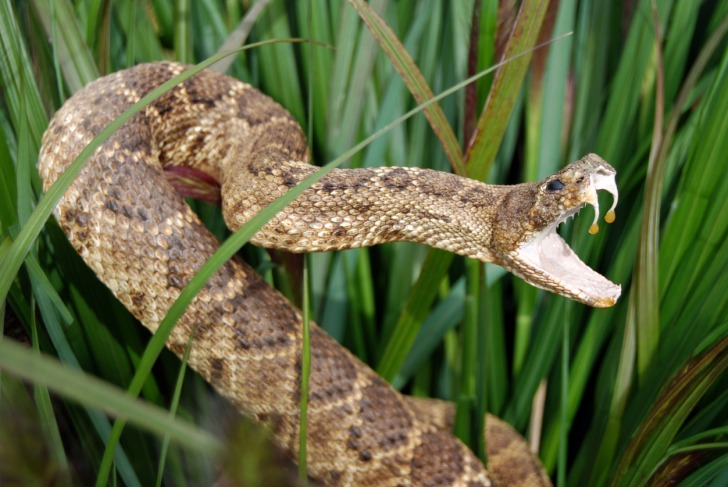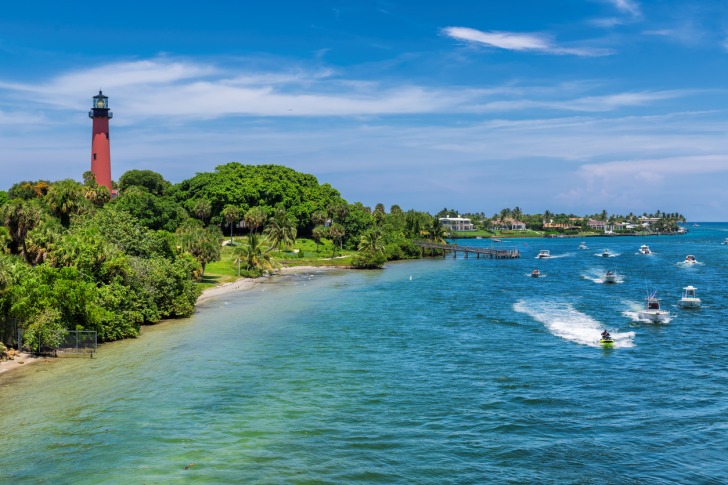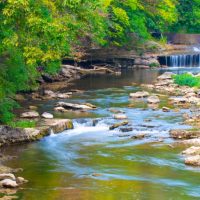Florida is known as the Sunshine State.
It is also the only state that borders both the Atlantic Ocean and the Gulf of Mexico.
If you’re going to be traveling to Florida, you may have to worry about snakes.
Florida has 44 different species of snakes that can be found in freshwater wetlands and salt marshes.
There are even some that live particularly well in residential areas.
This guide is going to provide you with useful information on snake species in Florida and safety tips should you encounter one.

Contents
- So, Are There Snakes in Florida?
- Snake Species in Florida
- 1. Florida Cottonmouth
- 2. Dusky Pygmy Rattlesnake
- 3. Eastern Diamond-backed Rattlesnake
- 4. Harlequin Coral Snake
- 5. Eastern Copperhead
- 6. Timber Rattlesnake
- 7. North American Racer
- 8. Red Cornsnake
- 9. Eastern Ratsnake
- 10. Ringneck Snake
- 11. Eastern Coachwhip Snake
- 12. Southern Watersnake
- 13. Pine Woods Littersnake
- 14. Common Garter Snake
- 15. Rough Green Snake
- 16. Scarlet Snake
- 17. Scarlet Kingsnake
- 18. Gray Ratsnake
- 19. Red-bellied Mud Snake
- 20. Dekay’s Brown Snake
- 21. Brown Watersnake
- 22. Florida Brown Snake
- 23. Eastern Indigo Snake
- 24. Eastern Ribbonsnake
- 25. Eastern Hognose
- 26. Rainbow Snake
- 27. Red-bellied Snake
- 28. Saltmarsh Snake
- 29. Eastern Kingsnake
- 30. Black Swamp Snake
- 31. Florida Kingsnake
- 32. Florida Crowned Snake
- 33. Eastern Pine Snake
- 34. Smooth Earthsnake
- 35. Midland Water Snake
- 36. Striped Swamp Snake
- 37. Northern Mole Kingsnake
- 38. Mississippi Green Watersnake
- 39. Glossy Swampsnake
- 40. Rough Earthquake
- 41. Appalachicola Kingsnake
- 42. Plain-bellied Watersnake
- 43. Southeastern Crowned Snake
- 44. Short-tailed Kingsnake
- Is it Safe to Go on a Trek in Florida?
- Interesting Snake Facts in Florida
- 3 Safety Tips for Exploring Nature in Florida
- Summary
- Florida Safety Overview
- Frequently Asked Questions
So, Are There Snakes in Florida?
There are 44 different species of snakes in Florida, all of which can be found in various habitats, including the dry uplands.
However, only six out of the 44 snake species are considered venomous, including the southern copperhead, the timber rattlesnake, the southern copperhead, the eastern diamondback rattlesnake, the cottonmouth, and the dusky pygmy rattlesnake.
Fortunately, the majority of snakes found in Florida are harmless and can be seen as useful as they eliminate rodents.
Interestingly enough, the most venomous snakes don’t pose a threat unless you step on them or threaten them.
Snake Species in Florida
Here is a list of the snake species that are found in Florida:
1. Florida Cottonmouth
The Florida Cottonmouth measures between 30 and 48 inches long.
They are venomous but not aggressive unless threatened.
They can be found throughout the state and on nearshore islands.
2. Dusky Pygmy Rattlesnake
The dusky pygmy rattlesnake is smaller and can be as short as 12 inches or as long as 24 inches.
They are characterized by a gray body with a red line across their backs.
They are also venomous and can be found throughout Florida.
3. Eastern Diamond-backed Rattlesnake
Also, venomous and found in Florida is the eastern diamond-backed rattlesnake.
They measure between 33 and 72 inches long and have thick bodies with diamond patterns across their backs.
4. Harlequin Coral Snake
The harlequin coral snake is also one of the most venomous snakes in Florida.
They can be as long as 30 inches and are characterized by having patterns of red and black bands.
5. Eastern Copperhead
Eastern copperheads are not easy to find or see while they are hiding due to their tan and brownish coloring.
They can be as long as 36 inches and are mainly found in the Panhandle area of Florida.
6. Timber Rattlesnake
Timber rattlesnakes are characterized by having light gray bodies with all-black tails.
They can be as long as 60 inches and are only found in 12 counties in Florida.
7. North American Racer
The North American racer snake is a slender snake that is all black.
It can be anywhere from 20 to 56 inches in length.
They are non-venomous and can be found throughout Florida.
8. Red Cornsnake
Red corn snakes are also found throughout Florida and can be anywhere between 30 and 48 inches long.
They are characterized by being orange-brown.
They also have black-ringed spots and are non-venomous.
9. Eastern Ratsnake
Eastern Ratsnakes can be as long as 72 inches.
They can also vary in color depending on where they are located.
For example, in the panhandle, they are gray with dark blotches.
On the Florida peninsula, they can be tan, gray, yellow, or orange.
10. Ringneck Snake
Ringneck snakes are easily identifiable by their slate-black bodies.
They are slender and have a yellow ring around their necks.
They are typically anywhere between 8 and 14 inches long.
They are also non-venomous.
11. Eastern Coachwhip Snake
Eastern coachwhip snakes are non-venomous snakes that can be found anywhere in Florida except in the wetlands or the Florida Keys.
Their heads can either be black or dark brown.
The rest of their bodies can be white or tan.
They can be anywhere between 42 and 60 inches long.
12. Southern Watersnake
Banded watersnakes are thick snakes that are dark.
They can be red, black, or brown.
They can be as long as 42 inches and can be found anywhere in Florida, except the Florida Keys.
13. Pine Woods Littersnake
Pine Woods Littersnakes are slender-bodied snakes that can either be reddish-brown or reddish-orange.
They have white or yellow bodies and can be anywhere between 10 and 13 inches long.
They are found mostly in the eastern or southern parts of Florida.
14. Common Garter Snake
These snakes are slender, long, and mainly dark.
They are characterized by having three lines that run down their backs and can be either yellow or white.
They can grow to 26 inches in length and are non-venomous.
15. Rough Green Snake
Rough green snakes are bright-colored snakes.
They are green with yellow or tan stomachs.
They can be anywhere between 14 and 33 inches long and can be found anywhere in Florida.
16. Scarlet Snake
Not to be confused with the scarlet kingsnake, the scarlet snake has large blotches that look similar to rings found on other snake species.
They also have white bellies and many large red patches on their bodies.
They can be as long as 20 inches and are located throughout the state.
17. Scarlet Kingsnake
Scarlet kingsnakes are sometimes confused with coral snakes, but they are not venomous.
They are characterized by having black, white, yellow, or red rings throughout their bodies.
They can be 14–20 inches long and can be found anywhere in Florida.
18. Gray Ratsnake
Gray Ratsnakes are lighter-colored snakes with dark gray blotches over their bodies.
They can be anywhere between 42 and 72 inches long and are mainly found in the panhandle of Florida.
19. Red-bellied Mud Snake
Mudsnakes have thick bodies with colored patterns on their bodies.
They can be anywhere between 40 and 54 inches long, and they are also non-venomous.
They can be found anywhere in Florida except the Florida Keys.
20. Dekay’s Brown Snake
These snakes are slender-built and can be light tan or even dark brown.
They also have dark spots on their spines.
They can be anywhere between 9 and 13 inches long.
They can be found in the Panhandle area.
21. Brown Watersnake
Brown watersnakes are typically dark brown or black with square spots.
They are sometimes mistaken for rattlers or cottonmouth snakes.
They can be as long as 60 inches and are non-venomous.
22. Florida Brown Snake
These snakes are thin and small.
They are typically tan, brown, or light brown.
They also have lines that run down their backs.
They can grow to be 13 inches long and can be found on the eastern coast of Florida.
23. Eastern Indigo Snake
These snakes are large and can be anywhere between 60 and 82 inches.
They are non-venomous and are characterized by having glossy black bodies.
24. Eastern Ribbonsnake
Eastern ribbonsnakes are slender and dark.
They can range from olive green to black.
They can also have blue, light green, white, or yellow stripes.
They can be as long as 26 inches and are non-venomous.
25. Eastern Hognose
These snakes have stocky bodies and can be in a range of colors, including orange, brown, tan, brown, black, or even yellow.
They can be as long as 33 inches and are known for not biting people.
26. Rainbow Snake
Rainbow snakes are glossy black and have thick bodies.
They can grow to be 27–48 inches long.
They are mostly found in the Panhandle area of Florida.
27. Red-bellied Snake
These snakes are thin, small, and mainly reddish-brown or gray.
They can be anywhere between 8 and 10 inches and are mostly found in the northern area of Florida.
28. Saltmarsh Snake
Saltmarsh Snakes are darker.
They can be olive green or even orange.
They also have light stripes that run along their backs.
They can be anywhere between 15 and 30 inches in length.
29. Eastern Kingsnake
Eastern kingsnakes can either be black or dark brown with light yellow or white rings on their bodies.
They can grow to be 48 inches long and are not venomous.
They are mainly found in the northern part of the state.
30. Black Swamp Snake
Black swamp snakes have black backs and red stomachs.
They can grow to be 15 inches long and are mainly found in the central and panhandle regions of Florida.
31. Florida Kingsnake
Florida kingsnakes stand out due to their distinct colors.
They are known to have brown or yellow colors along their bodies and can be as long as 48 inches.
They are mainly found in the Florida Keys and are non-venomous.
32. Florida Crowned Snake
These snakes are thin, small, and can be light reddish-brown or tan.
They typically have black or dark brown heads and light bellies.
They can be as long as 9 inches and are found in the southern part of the state.
33. Eastern Pine Snake
Eastern pine snakes are thick and large, with wide heads.
They are light in color and are characterized by having brown or red spots.
They can be anywhere between 48 and 66 inches long.
They are mainly found in the southern parts of Florida, the Florida Keys, and the Everglades.
34. Smooth Earthsnake
Smooth earthsnakes can be reddish brown or brown.
They also have spots on their backs.
They can be as long as 10 inches and are mainly found in the Panhandle area of Florida.
35. Midland Water Snake
Midland water snakes can be either light tan or light brown, with dark red or brown crossbands that run along their backs.
They are 24–30 inches long and are only found in the western area of the Panhandle.
36. Striped Swamp Snake
These snakes are brown with cream and yellow bellies.
They can be anywhere from 13 to 20 inches long.
They are typically found in the eastern Panhandle area of Florida.
37. Northern Mole Kingsnake
Northern mole kingsnakes can be orange, brown, or gray.
They also have 55 red spots on their backs.
They can be anywhere between 30 and 42 inches long and are mainly non-venomous.
38. Mississippi Green Watersnake
These snakes are sometimes confused with cottonmouth snakes.
They are non-venomous, unlike the cottonmouth snake.
They are all black and can grow to 55 inches in length.
39. Glossy Swampsnake
Glossy Swampsnakes can be olive green or brown.
They also have dark stripes that run along their sides.
They can be between 14 and 24 inches long.
40. Rough Earthquake
Rough Earthsnakes are characterized by being gray or brown with yellow or white stomachs.
They can grow to be anywhere between 7 and 10 inches long.
They are mainly found in the western region of the Panhandle.
41. Appalachicola Kingsnake
These snakes are similar in appearance to other kingsnake species.
They can vary in color, but they are mostly light.
They are typically between 36 and 48 inches long and can be found in the eastern and central Panhandle areas.
42. Plain-bellied Watersnake
Plain-bellied watersnakes can be reddish-brown or greenish-gray in color.
They have thick bodies with no patterns.
They can be as long as 48 inches and are non-venomous.
They are found in the western Panhandle region.
43. Southeastern Crowned Snake
The southeastern-crowned snake can be tan or reddish-brown.
They are also characterized by having a light band directly behind their heads.
It resembles a crown.
They can be anywhere between 8 and 10 inches long.
44. Short-tailed Kingsnake
The short-tailed kingsnake is not as long as other kingsnake species.
It is slender and has dark spots with gray bodies.
They are 14–20 inches long and are typically found in the St. John’s River.
They can also be found in central Florida.

Is it Safe to Go on a Trek in Florida?
Hiking in Florida can be safely done as long as you take the necessary precautions to remain safe.
The chances of seeing a snake while hiking in Florida are pretty high.
However, while crossing logs on the trail, make sure you check for snakes before you hop to the next log.
Stepping on a snake by accident can cause it to attack you.
It’s typical for snakes to hide on rocks to stay warm.
But besides snakes, you’ll also have to worry about bears and hogs.
There are more than 11,000 black bears in Florida.
You may also encounter hogs along your walk.
Yet they are more active at dawn and dusk.
While hiking, you must stay aware of your surroundings.
Interesting Snake Facts in Florida
The largest and most dangerous snake in Florida is the eastern diamondback.
In addition, it also ranks on the list of the most venomous snakes in the entire world.
So, if you ever cross paths with an eastern diamondback snake, proceed with caution.
The largest python ever to be captured in Florida measured 19 feet and had a weight of 125 pounds.
This was a story that made headlines back in 2019.
Furthermore, there were remains of white-tailed deer hooves still in the stomach of the python.
The most common snake in Florida is the southern ring-necked snake.
These snakes are typically found on walkways, leaf litter, and even hidden in mulch.
It’s even possible for them to fall into swimming pools and end up in your home!
Fortunately, they never try to bite.
3 Safety Tips for Exploring Nature in Florida
While hiking or just enjoying nature in Florida, here are a few safety tips to keep in mind:
- Hike with a friend. Hiking with at least one other person will provide a safety net in the event you are injured by wildlife or become sick. Hiking with another person also reduces the chances of harassment.
- Check ahead for trail closures. Before you head out to the trails, be sure that you check the trail closures and notices page. You can access this information by going to the FTA website.
- Make noise. Making noise while enjoying nature in Florida is a great way to stay safe from wildlife. It’s easy to startle animals if you aren’t careful, which can result in an attack on you. So, if you happen to encounter an animal on your hike, make noise.
Summary
There are approximately 44 species of snakes in Florida.
Out of those, there are only six that are dangerous and considered venomous.
Snakes can be found in almost every single habitat in Florida, including residential areas.
It’s not uncommon to find snakes hiding in your garden or even your home.
But snakes aren’t the only creatures to be wary of while hiking or enjoying nature in Florida.
There are also black bears and hogs that you may encounter while hiking.
However, if you remain vigilant and take the necessary precautions, your time outdoors can be enjoyable and safe.
Florida Safety Overview
READ THE FULL REPORT: Florida Safety Review
Safety Index:
- OVERALL RISK: MEDIUM
- TRANSPORT & TAXIS RISK: MEDIUM
- PICKPOCKETS RISK: MEDIUM
- NATURAL DISASTERS RISK: MEDIUM
- MUGGING RISK: MEDIUM
- TERRORISM RISK: HIGH
- SCAMS RISK: MEDIUM
- WOMEN TRAVELERS RISK: LOW
Frequently Asked Questions
How common is it for snakes to get into homes in Florida?
When the weather breaks, it’s not unusual to find snakes hiding in your home, basement, crawl spaces, or even garage.
While this is a common occurrence, it’s otherwise rare to ever experience a snake infestation in your home since snakes are not only in one location.
What should I do if I ever encounter a snake?
If you ever encounter a snake, be sure that you leave the snake alone.
You can easily identify the species by its characteristics.
As long as the snake isn’t inside your home or building and is not venomous, leave it alone.
If you happen to encounter one in your yard and it is venomous, it should be removed.
You can contact law enforcement or animal control.
What should I do if I get bit by a snake?
If you get bitten by a snake, be sure to treat it like any other cut or wound.
This prevents it from becoming infected.
Never hesitate to seek medical attention following a snake bite.
If the snake that bites you is venomous, call 911 or get to the hospital right away.
Do try to remain calm and avoid cutting open the bite wound.











